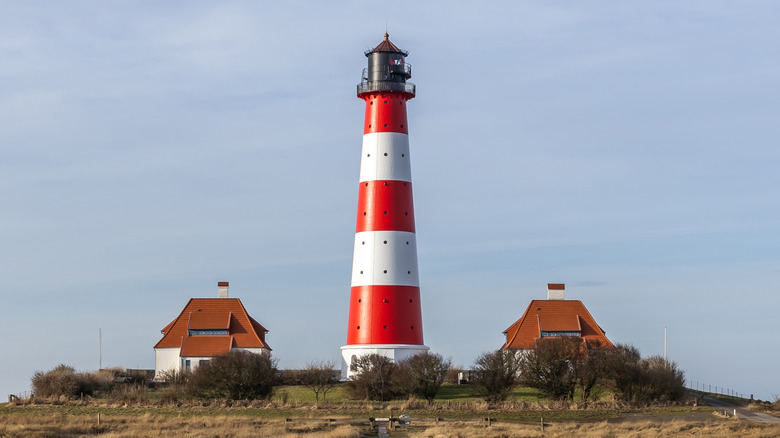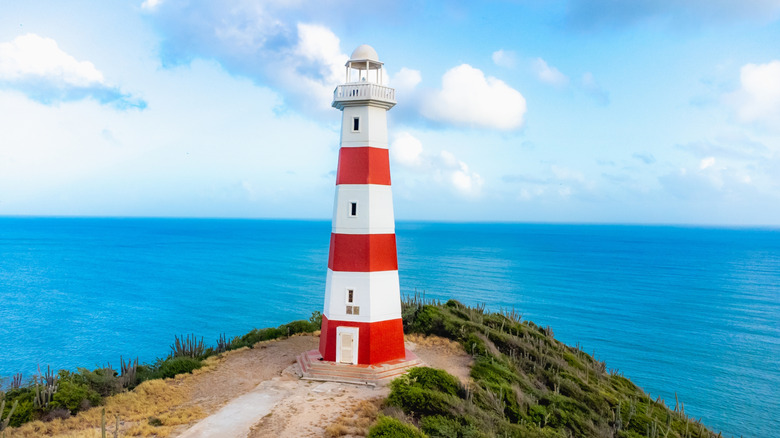Why Do Some Lighthouses Have Red And White Stripes?
For over two thousand years, lighthouses have been a constant and crucial element in maritime safety. Lighthouses function as important navigational aids that guide ships, warn of water hazards, and provide assistance during challenging weather conditions. Considered important installations, lighthouses can be found in coastal areas, islands, and busy waterways, serving as a beacon for seafarers. Lighthouses are painted in different colors that help distinguish the building during daytime from its surroundings, and one of the popular paint schemes used is red and white, which serves to differentiate it if its background is white cliff faces or rocky outcrops.
A lighthouse is designed to be tall, and its height can range from 33 feet to nearly 210 feet. This size is necessary so ships can easily see it and to offset the Earth's curvature and increase the distance at which its light can be visible. Lighthouses can be made from different materials, including concrete, wood, brick, and steel, and are engineered to withstand the repeated battering from the destructive power of ocean waves and severe weather conditions. Lighthouses can differ in design, ranging from square, cylindrical, or conical, which depends on their location, function, and environmental conditions.
Despite the availability of advanced navigational devices, lighthouses are still being used today. The equipment inside lighthouses includes its lighting beacon, composed of a powerful light source, the lens which amplifies the brightness and focuses the light beam, and a rotating mechanism. Next, the lighthouse is also equipped with foghorns that are used to provide warnings to ships, give location bearings, and avoid hazards from its powerful long-range sound. Lastly, some lighthouses are equipped with radios and transmitters for communications with vessels and to transmit navigational and other information.
An important navigational facility
Alongside the other ways that ships used to navigate before GPS, lighthouses have helped ancient mariners even before the sternpost rudder was invented. The oldest mention of a lighthouse among historical texts is the Pharos of Alexandria, estimated to have been built around 280 B.C. Due to its imposing size and exceptional engineering and design for its time, the Pharos of Alexandria is considered one of the wonders of the ancient world. Another historically significant lighthouse is the Tower of Hercules, which has been around since the first century A.D. Located in the La Coruña harbour of northwest Spain, this relic of bygone times is remarkable, as it is still in operation today.
Lighthouses today have developed significantly from rudimentary fire-lit beacons to intricate automated buildings with cutting-edge lighting systems. Its evolution from using oil lamps to electric-powered lights and automated operations has greatly improved the capability of modern lighthouses. Additional recent improvements to lighthouses also include the use of solar power and weather sensors that dispatch real-time data to nearby ships.
While lighthouses may seem archaic due to the capabilities of digital navigation from GPS, lighthouses remain important to modern ocean navigation. Worldwide, there are currently over 20,000 active lighthouses, with the United States having constructed the most at 1,500. In addition to their primary purpose as navigation landmarks, lighthouses have also expanded their role to include facilitating scientific research, heritage preservation, and tourism. In addition, several lighthouse facilities now serve as meteorological stations, museums, and even hotels. As society has transformed the way these beacons of navigation are used, lighthouses are assured of their continued longevity and relevance for years to come.

